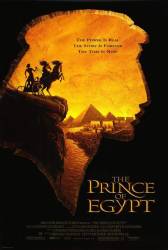Factual error: During the plague when the fire and rocks are falling from the sky, they fall behind a statue of Rameses and are seen through its hollow eye holes. It makes for a great image, but that would mean that the statue's eyes were punched out like a mask, even though before they were just carved into the stone.

The Prince of Egypt (1998)
Directed by: Simon Wells, Brenda Chapman, Steve Hickner
Starring: Ralph Fiennes, Michelle Pfeiffer, Sandra Bullock, Val Kilmer
Factual error: Ramses' sphinx was established in record time. Given the time between Moses' leaving Egypt and his return, there would not have been enough time for that Sphinx to be constructed. If the movie had conveyed the 40 year span between Moses' leaving and his return, the construction of that Sphinx would have been probable.
Suggested correction: There is nothing in the film to indicate that Moses hadn't been gone for forty years or more. He looks younger than that, but many people lived longer in those days, so Moses might look younger than he really is. It is not stated in the film how many years took place between Moses' flight from Egypt and his return, so it is impossible to say whether or not it was less than forty years.
Modern research suggests it may have taken much less than forty years to construct the Great Sphinx Of Egypt. Archaeologists have spent much time trying to establish how long it might have taken the Ancient Egyptians to build the great monuments, temples and structures of Pharaonic Egypt, considering the resources, manpower and technology available at the time. This has also been examined by modern engineers who have practical knowledge of the problems that people might have been faced with in building such incredible structures. It is uncertain if there will ever be any fully accepted consensus, but there is now general agreement that the Ancient Egyptians were highly intelligent and might have been able to build these structures in a relatively short time. The website interestingengineering.com has a webpage about the Great Sphinx, and it, quite credibly, suggests that a workforce of one hundred people could have constructed the Great Sphinx in a mere three years.
Continuity mistake: After Moses accidentally kills the guard at the temple, someone points out Moses as the killer and they point straight up. However, we see a shot from behind Moses while he stares at the fallen guard and the angle in that shot between where Moses stands and the fallen guard and the crowd around him is inconsistent with the scene where someone points Moses out. The body and group have moved from just below the scaffolding to several feet away.
Trivia: 2 differences between The Bible and the Movie. 1) Aaron did not doubt Moses in the Bible. In fact Aaron did most of the speaking before Pharaoh and actually performed some of the miracles. 2) Moses murdered the Egyptian task master. He did not accidentally kill him. Pharaoh wanted to kill Moses because of this, not try to convince him to stay.
Trivia: The song the Hebrew children sing as they are leaving Egypt was actually sung when they were celebrating the defeat of the Egyptian army at the Red Sea.
Miriam: There can be miracles, when you believe Though hope is frail, it's hard to kill Who knows what miracles you can achieve When you believe, somehow you will You will when you believe.
Rameses: I will not be the weak link.
Miriam: Moses, hear what I say. I have been a slave all my life. And God has never answered my prayers until now. God saved you from the river, He saved you in all your wanderings, and even now, He saves you from the wrath of Pharaoh. God will not abandon you. So don't you abandon us.
Question: During the song "When you Believe" a little girl says a bunch of stuff in Hebrew. What is she saying, and what is the translation for it?
Answer: "Ashira ladonai ki gaoh gaah, Ashira ladonai ki gaoh gaah, Michamocha baelim adonai, Mikamocha nedarba kodesh, Nachitah v'chas d'cha am zu gaalta, Nachitah v'chas d'cha am zu gaalta, Ashira, ashira, ashira..." "I will sing to the lord, for He has triumphed gloriously, I will sing to the Lord, for he has triumphed gloriously, Who is like you, O Lord, among the Celestial? Who is like you, majestic in Holiness? In your love You lead the people You redeemed, I will sing, I will sing, I will sing..."
Question: What does Moses' birth mother say in Hebrew as she's getting him ready to take to the river?
Answer: "Yal-di ha-tov veh ha-rach (my good and tender son) Al ti-ra veh al tif-chad (Don't be frightened and don't be scared) My son, I have nothing I can give, but this chance that you may live, I pray we'll meet again, If He will deliver us!"
I was wondering that. Thanks.
Question: The Queen of Egypt (I'm pretty sure her name is Tuya, but is she ever named in the film?) is portrayed as being a kind person almost every time she appears, but in the very beginning there is a moment I don't understand. When she's holding baby Moses, she throws dirty looks at the two servant girls who are with her, for seemingly no reason. What gives?
Join the mailing list
Separate from membership, this is to get updates about mistakes in recent releases. Addresses are not passed on to any third party, and are used solely for direct communication from this site. You can unsubscribe at any time.
Check out the mistake & trivia books, on Kindle and in paperback.



